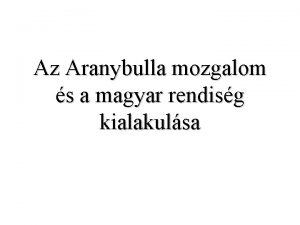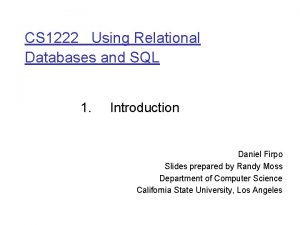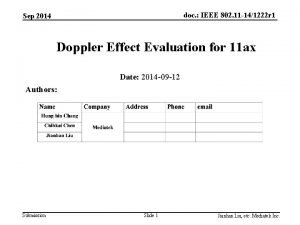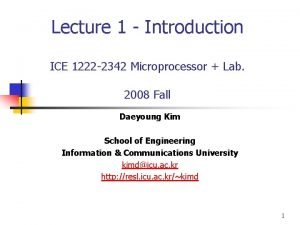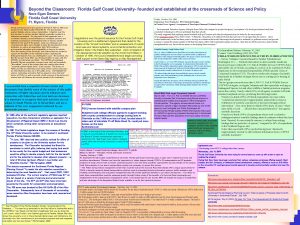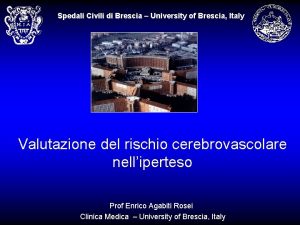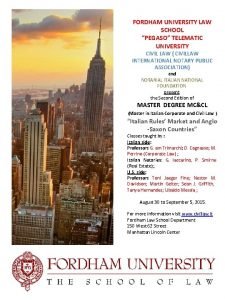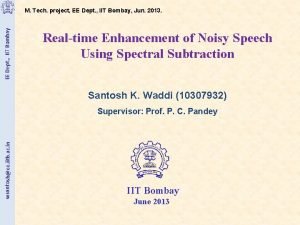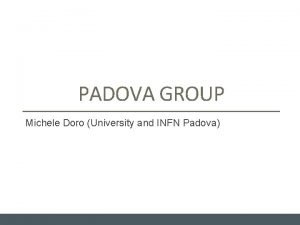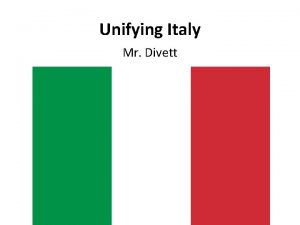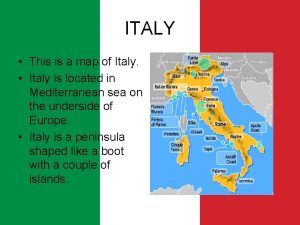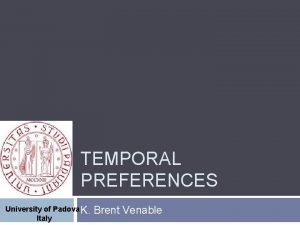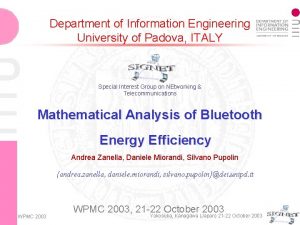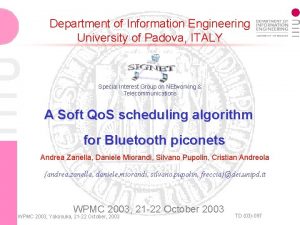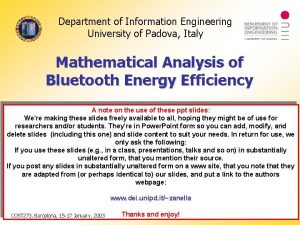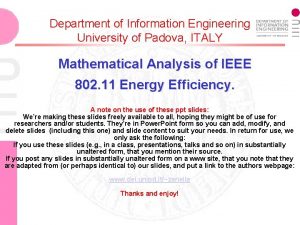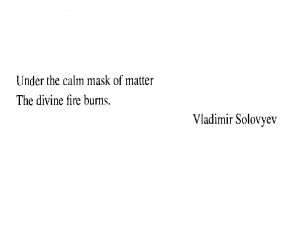University of Padova Italy founded 1222 Dept of
























- Slides: 24

University of Padova, Italy (founded 1222) Dept. of Physics and Astronomy National Insitute of Nuclear Physics Lorenzo FORTUNATO Pairing in 6 He, Giant Pairing Vibrations in Carbon and pair-transfer in reactions

Outlook of presentation I will give a brief account of some of the research in theoretical nuclear physics performed at the Dept. of Physics & Astronomy at Padova University focusing on pairing related phenomena: • Pairing in Borromean 6 He system: ground state stability, excited states and E. M. response [with J. Singh, R. Chatterjee and A. Vitturi, PRC 90 (2014) 064301 ] • Evidence for the existence of Giant Pairing Vibrations in carbon isotopes [Cappuzzello, F. et al. Signatures of the Giant Pairing Vibration in the 14 C and 15 C atomic nuclei. Nat. Commun. 6: 6743 (2015) ] • Pairing correlations in microscopic two-particle transfer reactions: 112 Sn, 32 Mg, and 68 Ni [J. A. Lay, L. Fortunato, and A. Vitturi, PRC 89 (2014) 034618]

1) Pairing in 6 He Both experimentally and theoretically there are still large uncertainties on the structure of light systems close to the drip-line. The case I want to discuss is 6 He and its connections with 5 He. • 4 He is very tightly bound (core exc. are at very high energy) • 5 He is unbound (two low-lying resonances) • 6 He is weakly bound in its g. s. and it has a number of resonances that have been recently re-investigated at GANIL. 6 He is borromean it has halo features and one would like to understand the role of the pairing interaction in making it bound. *** X. Mougeot et al. , Phys. Lett. B 718, 441 (2012). p(8 He, t) reaction In addition, new and still not very much investigated data claim the existence of a dozen new excited states of 6 He: 1. Highly Excited States of 6 He - Yu. B. Gurov, et al. Bulletin of the Russian Academy of Sciences. Physics, 2015, Vol. 79, No. 4, pp. 470– 473. 2. Spectrum of resonance states in 6 He. Experimental and theoretical analyses - O. M. Povoroznyk, V. S. Vasilevsky Ukr. J. Phys. 2015. Vol. 60, No. 3

Pairing in 6 He A phenomenological alpha-n potential is adjusted to correctly reproduce the p-resonances of 5 He (doublechecked with S-matrix poles analysis)

Two-particle states built out of single-particle continuum states Each single-particle unbound orbital reads : The two-particle states can be constructed as : p 3/2 p 1/2 0+, 2+ 1+, 2+ p 1/2 0+ Total of 5 states built from p 2 configurations We are updating our model-space in order to include s- and d- continuum waves that will allow the treatment of electric dipole transitions in 6 He and other features (See Back-up slides for complete table).

Procedure Construct 5 He p 3/2 and p 1/2 states from 0 -10 Me. V Calculate the matrix elem. with Pairing interaction Construct the twoparticle basis states with given J ( ~ 9 Gb !! ) (2. 4 Gb each !) Very computationally demanding !!! (Data storage) ( 0. 5 Mb ) Diagonalize the total hamiltonian: Get eigenvalues and eigenvectors ( ~ 9. 7 Gb !! ) g H= ε 1+ε 2+<|V|> This needs to be adjusted to available data. Not known a priori.

Results for different basis size (=density of states)

Results : bound ground state The binding is due to the pairing interaction! The g. s. has a nice exponentially decaying behaviour despite being the superposition of 20000 coupled s. p. continuum states (E C>0)!

Quadrupole E 2+ response to continuum Centroid ~0. 76 Me. V Width ~0. 2 Me. V Centroid ~2. 91 Me. V Width ~1. 8 Me. V The calculation is limited to a reduced model space containing only (p 3/2)2 configurations (that is 0+ and first 2+), used to find the appropriate value for the pairing strength that reproduces the narrow 2+ resonance. L. Fortunato

Preliminary results from J. Singh - About 140° and slightly smaller About 40° and slightly larger and more diffuse Plot of density. Virtually identical to the results of Hagino and Sagawa PRC 72 (2005) L. Fortunato

Preliminary results from J. Singh – E 0 transition strength, shows a peak at low energies (0. 5 -0. 6 Me. V) dominated by s 2 components. No other excited 0+ strength visible! This suggests that using E 0 is not a good way to investigate excited 0+ states! L. Fortunato

2) Signatures of GPV observed in 14 and 15 Carbon Catania, Padova, Pisa (ITA) Orsay (FRA) Rio de Janeiro (BRA)

Signatures of GPV observed at MAGNEX-LNS, Italy Recently F. Cappuzzello and his team at the LNS (Laboratori Nazionali del Sud, Catania, Italy ) using the MAGNEX spectrometer have separated the ejectiles from the 12 C(18 O, 16 O)14 C and 13 C(18 O, 16 O)15 C reactions at 84 Me. V incident lab energy, determining energy spectrum and angular distributions.

Giant Pairing Vibration or GPV The elusive Giant Pairing Vibration is predicted (Bes and Broglia, 1977) to be a L=0+ collective excitation mode microscopically made by a coherent superposition of particle-particle (or hole-hole) states in analogy to the experimentally well-established coherent collective modes made of particle-hole states, known as giant (monopole, dipole, quadrupole, . . . ) vibrations, or GMR, GDR, GQR, etc. Evidence for the existence of this mode is crucial to demonstrate the assumption of particle-hole symmetry in nuclei. Figure from J. Piekarewicz, «Two more or less» , Nat. Phys. News&Views, Vol. 11 (2015)

A number non-conserving breathing mode. . . A+2 >R A R A-2 >R Can be «macroscopically» visualized as a breathing (monopole L=0) oscillation (back and forth) across different mass partitions.

Evidence for a 0+ collective mode The conclusion of the present investigation is that there is evidence for an accumulation of monopole strength (from the oscillations and from theoretical models) at about 16. 9 Me. V of excitation energy in 14 C [ and similarly at 13. 7 Me. V in 15 C] The collective character of this mode is investigated by comparing the extracted transfer probability with that of the L=0 ground state and the ratio is about 3. This is of course a model dependent extraction.

3) Pairing correlations in 2 n-transfer reactions Two-neutron transfer reactions are a wonderful tool to clarify spectroscopic data. We investigate the selectivity of (t, p), (18 O, 16 O), and (14 C, 12 C) reactions in enhancing the population of different states in selected targets : we have taken 112 Sn as an example of superfluid nucleus, and 32 Mg and 68 Ni to study shell evolution for exotic nuclei. I will discuss here only the case of 32 Mg, that is situated in the island of inversion, where the sequence of single-particle shell-model states is thought to be inverted w. r. t. the «standard» . The g. s. of 32 Mg should involve 2 n in the 0 d 3/2 shell model state, while a transition to the next excited 0+ state should involve the 0 f 7/2 orbital. We expect pairing correlations to induce mixing of configurations leading to orthogonal mixtures of 0 p-0 h states (|0>) with 2 p 2 h states ⇓⇑

32 -Magnesium: ratio of cross-sections in DWBA calcs.

Conclusions 1. Pairing interactions, collective modes based on pairing, pairing correlations in nuclear reactions are still largely unknown and largely experimentally and theoretically unexplored due to intrinsic difficulties. 2. Nonetheless they are at the very basis of our understanding of profound concepts like, for instance, the particle-hole symmetry in strongly interacting fermion systems. 3. They also provide precise tests for spectroscopic data and they allow the extraction of useful information on the microscopic structure of nuclei. This is especially relevant when moving away from beta-stability out to the drip-line in regions where the pairing interaction might turn out to be more than just a part of the residual interaction. I hope with this talk to have aroused interest in the fascinating series of phenomena based on pairing. Bedankt voor uwe aandacht !

Back-up slides

“Spectrum of resonance states in 6 He. Experimental and theoretical analyses “ O. M. Povoroznyk, V. S. Vasilevsky Ukr. J. Phys. 2015. Vol. 60, No. 3


Enlarged model space s- p- d- will allow calculation of E 0, E 1, E 2, E 3, M 1, among others. s 1/2 p 3/2 d 5/2 0+ 0 -, 1 - 1 -, 2 - 1+, 2+ 2+, 3+ 0+ 1+, 2+ 1 -, 2 - 2 -, 3 - 0+, 2+ 0 -, 1 -, 2 -, 3 -, 4 - 0+, 2+ 1+, 2+, 3+, 4+ p 3/2 d 5/2 • • • 0+: 1+: 2+: 3+: 4+: 0+, 2+, 4+ 5 states 3 states 7 states 2 states • • • 0 -: 1 -: 2 -: 3 -: 4 -: 2 states 4 states 3 states 2 states 1 state

 Rendi_sg
Rendi_sg Cs 1222
Cs 1222 Ieee 1222
Ieee 1222 Microprocessor
Microprocessor Mechanicistic
Mechanicistic Department of information engineering university of padova
Department of information engineering university of padova Department of information engineering university of padova
Department of information engineering university of padova Transilvania university of brasov campus
Transilvania university of brasov campus When was florida gulf coast university founded
When was florida gulf coast university founded Brescia university italy
Brescia university italy University of salerno province
University of salerno province Pegaso university italy
Pegaso university italy Finance departments
Finance departments Dept of education
Dept of education Gome dept
Gome dept Dept. name of organization
Dept. name of organization Affiliate disclodures
Affiliate disclodures Dept a
Dept a Gome dept
Gome dept Dept. name of organization (of affiliation)
Dept. name of organization (of affiliation) Ee dept iitb
Ee dept iitb Bromocicloesano
Bromocicloesano Dept of education
Dept of education Hoe dept
Hoe dept Ohio dept of developmental disabilities
Ohio dept of developmental disabilities
